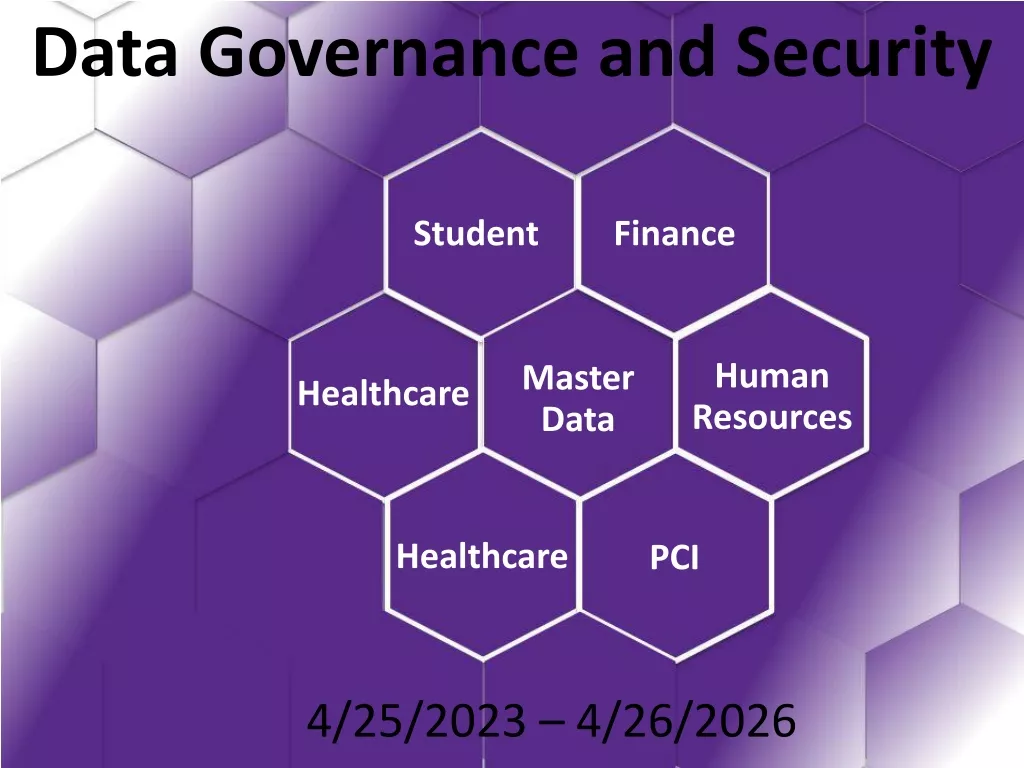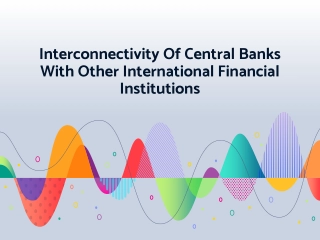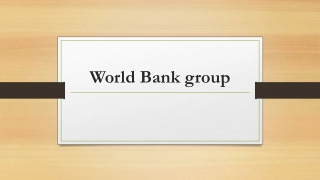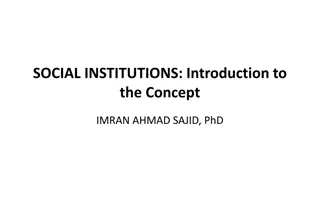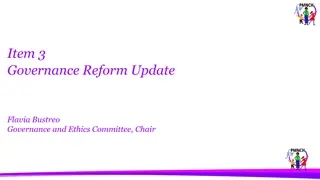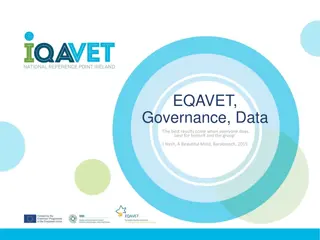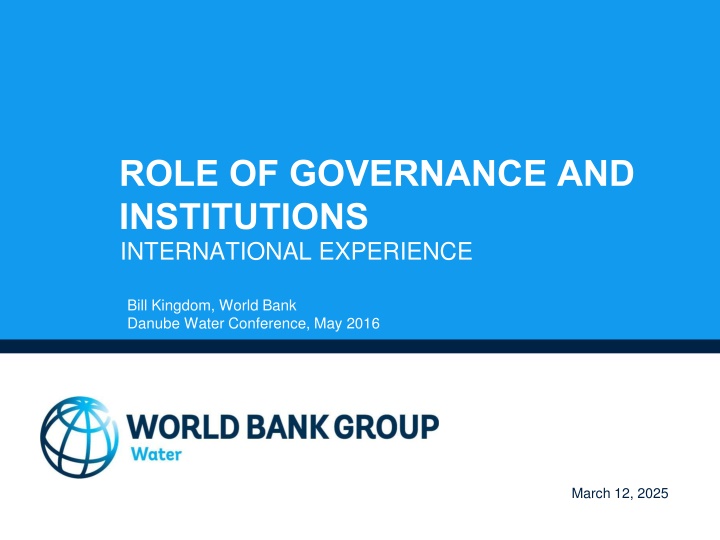
Role of Governance and Institutions in International Experience
Good governance and well-run institutions play a critical role in the effective operation of utilities, especially in responding to urban growth, expanding coverage to all consumers, investing in quality treatment, and providing services sustainably. The dimensions of a well-run utility include autonomy, accountability, customer orientation, and market orientation. Different public utility models and PPP options offer a wide range of approaches for service provision and management in the water sector. Aggregation can enhance service delivery by grouping municipalities under a single administrative structure.
Download Presentation

Please find below an Image/Link to download the presentation.
The content on the website is provided AS IS for your information and personal use only. It may not be sold, licensed, or shared on other websites without obtaining consent from the author. If you encounter any issues during the download, it is possible that the publisher has removed the file from their server.
You are allowed to download the files provided on this website for personal or commercial use, subject to the condition that they are used lawfully. All files are the property of their respective owners.
The content on the website is provided AS IS for your information and personal use only. It may not be sold, licensed, or shared on other websites without obtaining consent from the author.
E N D
Presentation Transcript
ROLE OF GOVERNANCE AND INSTITUTIONS INTERNATIONAL EXPERIENCE Bill Kingdom, World Bank Danube Water Conference, May 2016 March 12, 2025
Good Governance and Institutions are Critical Only well run utilities operating in a stable and facilitating environment can: Respond to urban growth Expand, or facilitate expansion of, coverage to all consumers, including the poor Invest in improved quality of treatment both drinking water and wastewater Provide services in sustainable manner 1
Critical Dimensions of a Well Run Utility Autonomy~ being independent to manage professionally without arbitrary interference by others. This also includes financial autonomy. Accountability ~ being answerable to another party for policy decisions, for the use of resources, and for performance. Customer orientation~ Reporting and listening to clients. Market orientation ~ making greater use of markets and the introduction of market-style incentives. 2
Taxonomy of public utility models Corporatized Utilities/SPV Ring-fenced Department Department Ownership Government Owned PLC StatutoryBody Ownership Corporate oversight Corporate oversight Ownership Ownership Service Provision Corporate oversight Corporate oversight Service Provision Service Provision Service Provision public law private law 3
PPP - Wide Range of Options Type of PPP Duration Responsibility of Operator/Contractor Payment Asset Ownership Service Contract 1-5 years Specific task (NRW management, leak detection, meter reading, All O&M excluding Investments All O&M including renewal excl. other investments All O&M and investments All Fee Public Management Contract Lease/ Affermage Concession 3-5 years Fee Public Contractual tariff Contractual tariff Tariff set by municipality Contractual tariff Public 8-15 years 20 30 years Long term Private then public Public or mix Mixte Empressa Divestiture Duration of All Private license license Palembang, PPPs International Perspective, June 4-7, 2007 4
The role of aggregation Grouping of several municipalities into a single administrative structure for the provision of a service Aggregated service provider town A town B aggregation town D town C 5
Aggregation - some challenges Dispersed nature of urbanization what constitutes economy of scale? Varying efficiencies of service provision and cost recovery Varying inherited asset stock and investment needs The process needs to be considered: Mandatory Voluntary Voluntary with strong incentives Other options supply side aggregation and professionalization Need to resolve the aggregation process, legal structure, and the voting rights up front. 6
Governance Arrangements: Voting Rights in Executive Board Method Power tilted to ++ and -- ++ Confidence for larger entity -- Small entities have limited influence Specific powers for the dominating entity larger entities ++ Democratic -- Small entities have limited influence % of population in each entity ++ A sound economic basis -- Varies from year to year # of connections or value of the assets One entity = one seat ++ Simple and transparent -- Can be unacceptable to larger entities smaller entities or a mixture of the various methods WBI/SEAWUN Leadership Forum, Ha Long, Vietnam, April 9-12, 2007 7 7
A traditional utility: accountability skewed towards local government Customers Utility National Government Local Government 8
Possible Reforms to Balance Accountabilities Reform measures: Increase revenue revenue revenue Customers Customers Increase Increase Customers Customers Local Source external funding funding National Government Source external Government Local National Government Utility Utility Government Utility Utility Introduce regulator Independent National Bank National Government Government Local Local Government Government regulator Bank
Improvements in governance of the utility and its operating environment have to go hand-in-hand Our goal good environment operating Typical reform path Possible combinations environment status/utility provider status poor poor good 10 utility
SECTOR GOVERNANCE Sector/Corporate Governance regime is implemented at three levels: 1. At a national level (level 1) establishing the commitment to corporate governance; 2. At the level of owner/company (level 2) establishing the relationship between the utility and its owners; and 3. At the company level (level 3) establishing the: The Board, with associated powers and capacity; The motivation and ability of staff to fulfill the Board s vision; and The company s integrity among consumers, the general public, and investors. 11 Source: USAID
CORPORATE GOVERNANCE Mechanisms and Examples Level 1: The National Commitment This commitment might take the form of a policy statement, a strategic framework for state-owned enterprises or a sector reform strategy statement. The statement makes transparent the government s intention to conform to its specified role and to delegate responsibilities to the level appropriate to the governance framework. Australia implemented the Strategic Water Reform Framework (1994) which set out long-term goals for economic and environmental sustainability including pricing reform based on consumption-based pricing and full-cost recovery, the reduction or elimination of cross-subsidies, and making subsidies transparent. 12 Source: USAID
CORPORATE GOVERNANCE Mechanisms and Examples Level 2: Relationship between Owners and Utility The relationship between the owners and utility is established by a contractual document(s) such as a license, a performance agreement or a shareholders agreement. The type of contract is influenced by the ownership structure, the legal environment, and local precedent. The document typically contains the agreed obligations of each party, the reporting and monitoring requirements, and any incentives or penalties. The document helps establish the channels of accountability and the degree of autonomy. 13 Source: USAID
CORPORATE GOVERNANCE Mechanisms and Examples Level 2: Relationship between Owners and Utility The contract(s) reiterates the higher level commitment to commercial sustainability . Sydney Water is governed by an Operating License requiring Sidney Water to: be a successful business and to this end operate at least as efficiently as any comparable business (and) maximise the net worth of the State s investment in Sydney Water . Sydney Water s Board must prepare a Statement of Corporate Intent (SCI) with commercial performance targets agreed between Sydney Water and shareholders. Sydney Water's revenue, operational and capital budgets form the basis of these targets. Penalties are set out . The Sydney Water Act includes guidance on the enforcement of the operating license including authority for the regulator to require remedial action, imposition of monetary sanctions and even termination of the license 14 Source: USAID
How can new institutional and governance models be encouraged? Performance based intergovernmental transfers Performance contracts Output based payments Performance based contracts for managers and staff Utility 4 1. State/Central government 2. 3. 1 4. 2 Local government 3 15
Building Utility Capacity Part of the Improvement Process Public sector reform (capacity building models) PPP: Control by private sector partner Professionalization contract Concessio n Management contract Operations outsourcing Technical assistance agreement Knowledge transfer partnership Classroom training by public or private institutions Twinning arrangement with public or private providers 16
The Professionalization Contractor a One to Many (standardized) model Provides these services Manuals with standard operating procedures, software and IT systems Business process reengineering and implementation Computer equipment and business software In-house turn-around experts for a period of years Training programs to turn around these functions of utility management Commercial system management Distribution system management Capital projects Utility administration Planning Human Resources Billing/collection Repairs Treatment plant operation Implementation Accounting/ financial management Meter reading Maintenance Financing Customer service NRW reduction Procurement 17
One to Many Professionalization Program with Performance Targets 18
Summary Creating the right environment is critical to good governance how to improve sector autonomy, accountability, customer orientation and market orientation? Governance is not just a utility issue need to consider national and municipal level governance as well Incentives underpin improved governance and performance at all levels Professionalization contracts could help improve capacity and new one to many models could be developed Crowding in private finance requires improved performance and good governance 19 Presentation Title
20 Presentation Title
Design of corporatization/SPV Sectoral laws, laws on SOEs, and/or specific laws/articles of agreement define: Composition and mandate of the Corporate Oversight Board Transparency and disclosure Financial procedures Personnel and procurement rules 21
Balancing external accountabilities Owners Policy makers/regulators Financiers Cooperate oversight board Service provider Customers Lobby groups 23
What is the correct balance of accountabilities? Each situation is different Diversify accountability (from triangle to rectangle to pentagon) Balance accountability (maximize the surface area) Expansion of the web of accountability will take many years Accountability to customers is consistently a critical success factor Private financiers provide long term balance 24
The need to build mature utilities Strategic Orientation Strategic Leadership Organizational Culture Customer Orientation Commercial Orientation Policy, Legal, Regulatory and Political Environment Managerial Autonomy External Accountability Partnerships and Networks Corporate Image Behavior Organizational Structure Empowerment Structure (Internal Autonomy) Internal Accountability Structure Influence Monitoring and Evaluation Information and Knowledge Management Internal and External Communication Continuous Improvement Human Resources Technical Operations Infrastructure Management Financial Management Performance Capability Tools
Initial Assessment in Two Water Utilities in Bangladesh Behaviour 5 4 3 2 Structure & Processes Influence 1 0 Technical Capabilities Tools CWASA DWASA 27

